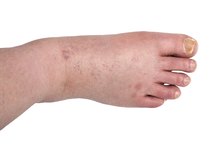Symptoms of Bright's Disease
Bright’s disease is an historical classification of kidney diseases that today includes acute and chronic nephritis (sometimes also known as nephritic syndrome or glomerulonephritis) 12. Nephritis is caused by an inflammation of the internal structures of the kidney 2. While about 50 percent of people who develop acute nephritis experience no symptoms, others may experience some common and generalized symptoms that can become serious if left untreated 2.
Common Symptoms
Inflammation of the kidneys and, in particular, the glomeruli (part of the kidneys that regulate filtering and ridding the body of wastes) causes excess fluid to build up in the body and protein and blood to be lost in the urine. Urine output typically decreases, and it becomes dark in color or cloudy due to protein and blood buildup. People with nephritis may develop enlarged neck veins due to increases in blood pressure, along with fluid overload in the abdomen and an enlarged liver that is palpable upon physical examination 2.
Generalized Symptoms
A List of Autoimmune Water Retention Diseases
Learn More
Bright’s disease can cause a number of generalized symptoms that affect the whole body. These symptoms may include:
- a rash
- blurred vision
- fever
- headache
- general malaise (feeling ill)
- muscle aches
- joint pain
A cough that produces a mucous containing a pink, frothy material may also develop. Many will also experience decreased alertness, drowsiness, fatigue and confusion.
Chronic and Serious Symptoms
In some cases, acute nephritis can progress to chronic glomerulonephritis, a serious condition characterized by a worsening of the glomeruli of the kidneys 2. According to the National Institutes of Health, at least one-third of those with acute nephritis will will experience a recurrence of the condition that eventually ends up in end-stage renal failure 2. Approximately 25 percent of people with chronic nephritis have no history of acute nephritis, reporting no overt symptoms until symptoms of kidney failure appear 2. They may also notice a change in the pigment of the skin, as it sometimes becomes brown or yellow in hue. Decreased sensation in the hands or feet, seizures, delirium or coma can also occur.
Related Articles
References
- NIH: Acute Nephritic Syndrome
- Lupus Nephritis. Medline Plus. Lupus and Kidney Disease. Lupus Foundation of America. January 2008.
- Lupus Nephritis. National Institute of Diabetes and Digestive and Kidney Diseases. April 2014.
Writer Bio
Based in New York City, Tricia Mangan began her writing career in 2001. She has co-authored a National Cancer Institute report and a number of research articles that have appeared in medical journals. Tricia holds a Master of Arts in clinical psychology from Stony Brook University and boasts diverse clinical, research and teaching experience.









